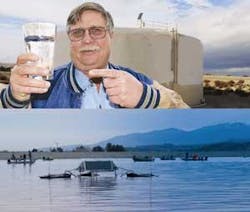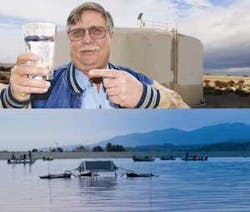Controlling Algal Blooms with Solar-Powered Circulation
by Chris Knud-Hansen and Michael Podwill
It’s a sound of summer that water treatment plant (WTP) operators would rather not hear: A ringing telephone announcing yet another customer complaining about water with an earthy, musty taste, a nasty odor and an unpleasant color. The culprit behind these problems is almost always cyanobacteria – otherwise known as blue-green algae.
Blue-green algae forms unsightly and foul smelling scum (it looks like a thick coat of bright green paint) on the surface of a lake. The unpleasant earthy and musty odor comes when blue-green algae produces MIB (methyl isoborneol) and geosmin.
During the summer, when warm temperatures, stagnant conditions and high nutrient availability coincide, those cyanobateria form dense mats -- or blooms. Periods of excessive growth are collectively known as harmful algal blooms (HABs). Making the problem even worse, many cyanobacteria produce very potent toxins.
Over the years, lake management experts have followed two strategies for dealing with HABs: Killing them with copper-based algaecides and starving them by restricting nitrogen and phosphorus availability via watershed management and/or nutrient removal or inactivation.
In the last few years, a third method has emerged and is considered by a growing number of lake managers to be a viable alternative. Solar-powered long distance circulation (LDC) can be effective, cost-efficient and an environmentally sound means for disturbing cyanobacteria’s preferred habitat and, in the process, providing the desired control.
Solar Powered Circulation
LDC has long been appreciated by those who believe habitat disturbance provides a major negative impact on cyanobacteria growth. However, it took the development and introduction of SolarBee™ solar-powered water circulation machines to make LDC a practical means for controlling HABs on water bodies of nearly any size.
SolarBee water circulators are floating up-flow pumps with a flexible intake hose that draws water up from any depth. The bottom plate beneath the one-meter diameter intake hose enables water to enter the pump horizontally from long distances, thus preventing re-suspension of bottom sediments, even when the system’s intake hose is less than a meter off the lake bottom.
On the surface, a specially designed distribution dish allows up to 10,000 gpm to move radially in all directions away from circulator. In this way, the upper waters, where cyanobacteria grow, are put into a slow but continuous motion. Meanwhile, three 80-watt solar panels provide enough energy to run the sealed, magnetic motor and the digital control box virtually all day and night. The system’s efficient design enables one unit to treat up to 35 acres of lake surface area.
Since 2000, SolarBee units have been installed in more than 200 lakes and other bodies of water around the world. The system’s have achieved a 95% success rate in providing LDC for HAB control. Over 80 municipal raw water storage reservoirs have installed the units. Taste and odor complaints have virtually disappeared, and the plants have saved money on chemicals which are no longer needed.
Case Study
Lake Palmdale, a 234 acre raw water reservoir (average depth: 18 feet), supplies the adjacent Palmdale Water Treatment Plant. The lake has had a history of intense algae blooms every summer. Blue-green algae caused frequent taste and odor problems. To control the algae blooms, the city would apply up to 2,000 pounds of copper sulfate every week from April through September.
Finally, the city’s Water Treatment Plant Supervisor, Greg Dluzak, sought a better way to deal with this chronic problem. In November 2002, he had six SolarBee SB10000 water circulators installed at strategic points throughout the lake. A year later a seventh unit was installed. In 2005, all seven were upgraded to the new SB10000v12 model.
Before SolarBee, Secci depths averaged 3 feet and chlorophyll a concentrations averaged 13.5 ug/L. After the installation, Secci depths averaged more than 6 feet and chlorophyll a averaged 6.6 ug/L. Dissolved oxygen levels were consistent down to the intake hose depths at 20 feet. Also, fish vigor and spawning are at unprecedented high levels.
With the improved circulation, healthy green algae predominates. There’s little or no harmful blue-green algae anymore. Because the city no longer uses copper sulfate, annual savings are some $65,000. Perhaps most telling of all is this fact: Before the project, water quality problems meant that the city could draw only 25% of its 30 mgd needs from the lake. With SolarBee circulators, Palmdale now draws over 60% of its water from the lake.
And, according to Dluzak, there are no more calls to complain about water taste or odor.
“Water quality, water clarity, economic improvement…on all counts, the City of Palmdale is very happy with SolarBee on the job,” he said.
About the Authors: Christopher F. Knudsen, Ph.D., is a limnologist employed by SolarBee Inc. Michael Podwill is a freelance writer based in New York.

